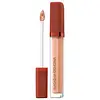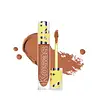What's inside
What's inside
 Key Ingredients
Key Ingredients

 Benefits
Benefits

 Concerns
Concerns

 Ingredients Side-by-side
Ingredients Side-by-side

Water
Skin ConditioningCI 77891
Cosmetic ColorantBis-Stearyl Dimethicone
EmollientCaprylyl Methicone
Skin ConditioningIsohexadecane
EmollientCetyl PEG/PPG-10/1 Dimethicone
EmulsifyingGlycerin
HumectantIsononyl Isononanoate
EmollientDiphenyl Dimethicone
EmollientCI 77492
Cosmetic ColorantPolyglyceryl-4 Isostearate
EmulsifyingTrimethylsiloxysilicate
EmollientC30-45 Alkyl Dimethicone
Skin ConditioningStearyl Dimethicone
EmollientAlumina
AbrasiveButylene Glycol
HumectantBoron Nitride
AbsorbentSodium Potassium Aluminum Silicate
Phenoxyethanol
PreservativeSodium Chloride
MaskingCI 77491
Cosmetic ColorantDisteardimonium Hectorite
StabilisingPotassium Sorbate
PreservativeSodium Dehydroacetate
PreservativeCaprylic/Capric Triglyceride
MaskingTriethoxycaprylylsilane
Tocopheryl Acetate
AntioxidantSilica Dimethyl Silylate
EmollientC20-24 Olefin
Skin ConditioningSilica
AbrasivePropylene Carbonate
SolventParfum
MaskingCI 77499
Cosmetic ColorantVitis Vinifera Fruit Extract
Skin ConditioningPortulaca Grandiflora Extract
Skin ConditioningCapsicum Annuum Extract
MaskingPentaerythrityl Tetra-Di-T-Butyl Hydroxyhydrocinnamate
AntioxidantWater, CI 77891, Bis-Stearyl Dimethicone, Caprylyl Methicone, Isohexadecane, Cetyl PEG/PPG-10/1 Dimethicone, Glycerin, Isononyl Isononanoate, Diphenyl Dimethicone, CI 77492, Polyglyceryl-4 Isostearate, Trimethylsiloxysilicate, C30-45 Alkyl Dimethicone, Stearyl Dimethicone, Alumina, Butylene Glycol, Boron Nitride, Sodium Potassium Aluminum Silicate, Phenoxyethanol, Sodium Chloride, CI 77491, Disteardimonium Hectorite, Potassium Sorbate, Sodium Dehydroacetate, Caprylic/Capric Triglyceride, Triethoxycaprylylsilane, Tocopheryl Acetate, Silica Dimethyl Silylate, C20-24 Olefin, Silica, Propylene Carbonate, Parfum, CI 77499, Vitis Vinifera Fruit Extract, Portulaca Grandiflora Extract, Capsicum Annuum Extract, Pentaerythrityl Tetra-Di-T-Butyl Hydroxyhydrocinnamate
Water
Skin ConditioningCaprylic/Capric Triglyceride
MaskingOctyldodecanol
EmollientPolyglyceryl-2 Dipolyhydroxystearate
Skin ConditioningEthylhexyl Olivate
Skin ConditioningGlycerin
HumectantUndecane
EmollientPolyhydroxystearic Acid
EmulsifyingMica
Cosmetic ColorantPolyglyceryl-3 Diisostearate
EmulsifyingSilica
AbrasiveGalactoarabinan
Propanediol
SolventHelianthus Annuus Seed Wax
Skin ConditioningTridecane
PerfumingLecithin
EmollientCaffeine
Skin ConditioningPanthenol
Skin ConditioningAcetyl Tetrapeptide-5
HumectantDipeptide-2
Skin ConditioningSodium Hyaluronate
HumectantSqualane
EmollientGlyceryl Oleate
EmollientPentylene Glycol
Skin ConditioningTocopherol
AntioxidantSodium Gluconate
Skin ConditioningHelianthus Annuus Seed Oil
EmollientAscorbyl Palmitate
AntioxidantHydrogenated Palm Glycerides Citrate
EmollientPhenethyl Alcohol
MaskingCI 77891
Cosmetic ColorantCI 77491
Cosmetic ColorantCI 77492
Cosmetic ColorantCI 77499
Cosmetic ColorantCI 77742
Cosmetic ColorantWater, Caprylic/Capric Triglyceride, Octyldodecanol, Polyglyceryl-2 Dipolyhydroxystearate, Ethylhexyl Olivate, Glycerin, Undecane, Polyhydroxystearic Acid, Mica, Polyglyceryl-3 Diisostearate, Silica, Galactoarabinan, Propanediol, Helianthus Annuus Seed Wax, Tridecane, Lecithin, Caffeine, Panthenol, Acetyl Tetrapeptide-5, Dipeptide-2, Sodium Hyaluronate, Squalane, Glyceryl Oleate, Pentylene Glycol, Tocopherol, Sodium Gluconate, Helianthus Annuus Seed Oil, Ascorbyl Palmitate, Hydrogenated Palm Glycerides Citrate, Phenethyl Alcohol, CI 77891, CI 77491, CI 77492, CI 77499, CI 77742
 Reviews
Reviews

Ingredients Explained
These ingredients are found in both products.
Ingredients higher up in an ingredient list are typically present in a larger amount.
This ingredient is an emollient, solvent, and texture enhancer. It is considered a skin-softener by helping the skin prevent moisture loss.
It helps thicken a product's formula and makes it easier to spread by dissolving clumping compounds.
Caprylic Triglyceride is made by combining glycerin with coconut oil, forming a clear liquid.
While there is an assumption Caprylic Triglyceride can clog pores due to it being derived from coconut oil, there is no research supporting this.
Learn more about Caprylic/Capric TriglycerideCi 77491 is also hydrated iron III oxide. It's sole purpose is to give a red/pink hue to products.
Iron III oxides are classified as inorganic chemicals for coloring.
Synthetically created Ci 77491 is considered safer than those naturally found. This is because the synthetically created version may contain less impurities. Iron oxides are generally non-toxic and non-allergenic.
Learn more about CI 77491Ci 77492 is also hydrated iron III oxide. It's sole purpose is to give a yellow hue to products.
Iron III oxides are classified as inorganic chemicals for coloring.
Synthetically created Ci 77492 is considered safer than those naturally found. This is because the synthetically created version may contain less impurities. Iron oxides are generally non-toxic and non-allergenic.
Learn more about CI 77492Ci 77499 is also hydrated iron III oxide. It is created from mixing red and black iron oxides. This helps give shades of darkness to a product.
Iron III oxides are classified as inorganic chemicals for coloring.
Ci 77891 is a white pigment from Titanium dioxide. It is naturally found in minerals such as rutile and ilmenite.
It's main function is to add a white color to cosmetics. It can also be mixed with other colors to create different shades.
Ci 77891 is commonly found in sunscreens due to its ability to block UV rays.
Learn more about CI 77891Glycerin is already naturally found in your skin. It helps moisturize and protect your skin.
A study from 2016 found glycerin to be more effective as a humectant than AHAs and hyaluronic acid.
As a humectant, it helps the skin stay hydrated by pulling moisture to your skin. The low molecular weight of glycerin allows it to pull moisture into the deeper layers of your skin.
Hydrated skin improves your skin barrier; Your skin barrier helps protect against irritants and bacteria.
Glycerin has also been found to have antimicrobial and antiviral properties. Due to these properties, glycerin is often used in wound and burn treatments.
In cosmetics, glycerin is usually derived from plants such as soybean or palm. However, it can also be sourced from animals, such as tallow or animal fat.
This ingredient is organic, colorless, odorless, and non-toxic.
Glycerin is the name for this ingredient in American English. British English uses Glycerol/Glycerine.
Learn more about GlycerinSilica, also known as silicon dioxide, is a naturally occurring mineral. It is used as a fine, spherical, and porous powder in cosmetics.
Though it has exfoliant properties, the function of silica varies depending on the product.
The unique structure of silica enhances the spreadability and adds smoothness, making it a great texture enhancer.
It is also used as an active carrier, emulsifier, and mattifier due to its ability to absorb excess oil.
In some products, tiny microneedles called spicules are made from silica or hydrolyzed sponge. When you rub them in, they lightly polish away dead skin layers and enhance the penetration of active ingredients.
Learn more about SilicaWater. It's the most common cosmetic ingredient of all. You'll usually see it at the top of ingredient lists, meaning that it makes up the largest part of the product.
So why is it so popular? Water most often acts as a solvent - this means that it helps dissolve other ingredients into the formulation.
You'll also recognize water as that liquid we all need to stay alive. If you see this, drink a glass of water. Stay hydrated!
Learn more about Water